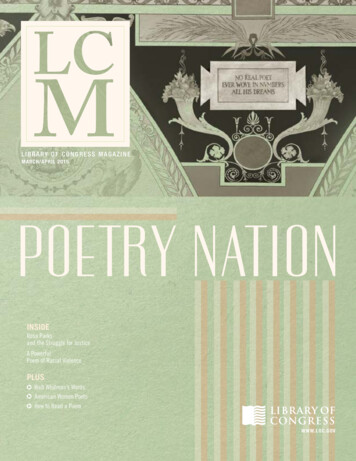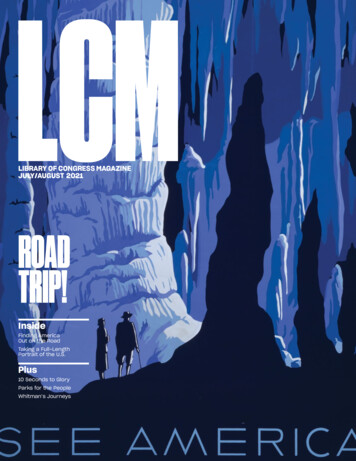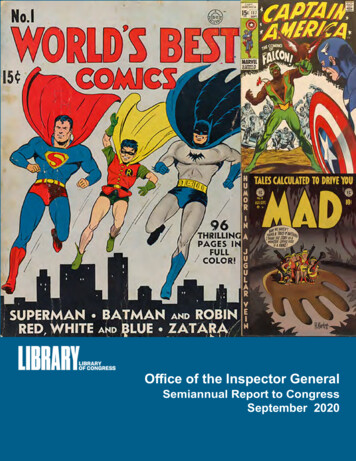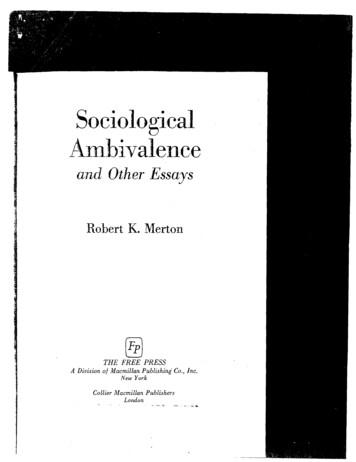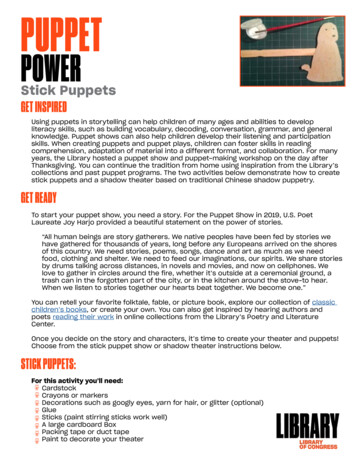
Transcription
PUPPETPOWERStick PuppetsGET INSPIREDUsing puppets in storytelling can help children of many ages and abilities to developliteracy skills, such as building vocabulary, decoding, conversation, grammar, and generalknowledge. Puppet shows can also help children develop their listening and participationskills. When creating puppets and puppet plays, children can foster skills in readingcomprehension, adaptation of material into a different format, and collaboration. For manyyears, the Library hosted a puppet show and puppet-making workshop on the day afterThanksgiving. You can continue the tradition from home using inspiration from the Library’scollections and past puppet programs. The two activities below demonstrate how to createstick puppets and a shadow theater based on traditional Chinese shadow puppetry.GET READYTo start your puppet show, you need a story. For the Puppet Show in 2019, U.S. PoetLaureate Joy Harjo provided a beautiful statement on the power of stories.“All human beings are story gatherers. We native peoples have been fed by stories wehave gathered for thousands of years, long before any Europeans arrived on the shoresof this country. We need stories, poems, songs, dance and art as much as we needfood, clothing and shelter. We need to feed our imaginations, our spirits. We share storiesby drums talking across distances, in novels and movies, and now on cellphones. Welove to gather in circles around the fire, whether it’s outside at a ceremonial ground, atrash can in the forgotten part of the city, or in the kitchen around the stove–to hear.When we listen to stories together our hearts beat together. We become one.”You can retell your favorite folktale, fable, or picture book, explore our collection of classicchildren’s books, or create your own. You can also get inspired by hearing authors andpoets reading their work in online collections from the Library’s Poetry and LiteratureCenter.Once you decide on the story and characters, it’s time to create your theater and puppets!Choose from the stick puppet show or shadow theater instructions below.STICK PUPPETS:For this activity you’ll need:CardstockCrayons or markersDecorations such as googly eyes, yarn for hair, or glitter (optional)GlueSticks (paint stirring sticks work well)A large cardboard BoxPacking tape or duct tapePaint to decorate your theater
PUPPETPOWERStick PuppetsCREATE YOUR PUPPETS!1. Using cardstock, draw your own puppet or print figures fromcoloring pages (for example, this dog, owl, fox, and hare fromthe Library’s Japanese woodblock collections), one of theLibrary’s poster collections (check out this hippo or panda!),or images in our popular Free to Use and Reuse images.2. Color your puppet (if necessary) and cut it out. Add any extra decorations you wouldlike, such as googly eyes or yarn hair.3. Glue the back of your puppet to a long, smooth stick. A paint stirring stick is perfect.
PUPPETPOWERStick PuppetsCREATE YOUR THEATER!1. Open the ends of a cardboard box for the puppet stage. Tapeone of the flaps closed so that you don’t reveal the hands of thepuppeteer.2. Paint and decorate the outside of your puppet theater any way youwant.3. Cut slim holes in the side to slide your puppets through.4. Place your puppet theater on a table and start the show!
PUPPETPOWERShadow TheaterThese Chinese shadow puppets are from Shaanxi province and were created in the 19th toearly 20th century. They survived the Tangshan earthquake of 1976 and the Cultural Revolution,when puppet theater was considered a counter-revolutionary art form. They are in Ann Roddy’spersonal collection.GET INSPIREDShadow Theater is everywhere in traditional Chinese life—in temples, the streets, thecountryside, the marketplace, and the human soul. Before shadow theater becamerecognized as a performance art, it was a form of imaginative entertainment. Shadows fromtrees played upon the wax windowpanes of traditional housing and inspired people to tellstories, much like people tell stories about the shapes they see in the patterns of stars. Aspeople began to use puppetry to complement these shadow stories, the idea that storiescould be told by the manipulation of natural entities like light and shadow empoweredpuppetry with deep meaning. People saw the puppets as sacred objects that had powerand influence larger than the performance. As puppetry linked to these natural and cosmicphenomenon spread throughout Asia, this understanding spread with it. Stephanie Hallfrom the American Folklife Center wrote in her blog post Puppets: A Story of Magical Actors,“Puppetry is often seen as both sacred and magical even today.”GET READYFor this activity you’ll need:CardstockBlack PaintSticks (paint stirring sticks work well)GlueA large cardboard BoxA roll of white paperPacking tape or duct tapeA small table lamp or camping lanternPaint to decorate your theater
PUPPETPOWERShadow TheaterCREATE YOUR PUPPETS!1. Draw or print your puppet characters on cardstock. There is anexample of a traditional Balinese puppet character here. The rarebook collections include this set of Chinese paper dolls [PDF]from the latter part of the Qing Dynasty (1644-1912) that canserve as either a template or inspiration. You can find additionalideas for characters in the stick puppet making section above.2. Cut your characters out and paint them black.3. Attach a stick to the back of each of your shadow puppets withtape. A paint stirring stick is perfect.
PUPPETPOWERShadow TheaterCREATE YOUR THEATER!1. Open the ends of a cardboard box for the puppet stage.Tape one of the flaps closed so you don’t reveal the handsof the puppeteer.2. Cut slim holes in the side to slide your puppets through.3. Paint and decorate the outside of your puppet theater.4. Attach white paper to the front and tape its edges securely.5. Place a small lamp or camping lantern at the back of yourtheater.6. Dim your room lights and start the show!
PUPPETPOWERShadow TheaterEXPLORE MORE!Check out this blog post about puppetry books in the Rare Book Collection at the Library.Read more about how to make puppets:Bryan, Ashley. Ashley Bryan’s Puppets. New York: Atheneum, 2014.Engler, Larry and Carol Fijan. Making Puppets Come Alive. New York: Dover, 1973.Kennedy, John. Puppet Mania. Cincinnati: North Light, 2004.Kennedy, John. Puppet Planet. Cincinnati: North Light, 2006.MacNeal, Noel. 10-Minute Puppets. New York: Workman, 2010.Read more about Shadow Theater:Broman, Sven. Chinese Shadow Theatre. Stockholm: Ethnographic Museum of Sweden,1981.Chen, Fan Pen Li. Chinese Shadow Theater, History, Popular Religion, and WomenWarriors. Ithaca: McGill-Queen’s University Press, 2007.Digital Museum of ShadowVisit the World Encyclopedia of Puppet ArtsView these Library webcasts focused on puppets (for parents and older siblings):African American Dollmaking and Puppetry: Renegotiating Identity, RestoringCommunityExperimental Shadow Theater in Contemporary Bali, Indonesia
Draw or print your puppet characters on cardstock. There is an example of a traditional Balinese puppet character here. The rare book collections include this set of Chinese paper dolls [PDF] from the latter part of the Qing Dynasty (1644-1912) that can serve as
